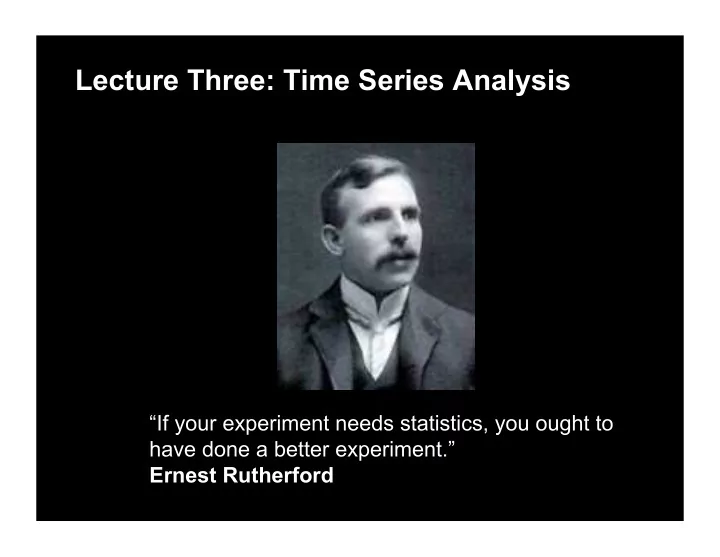

Lecture Three: Time Series Analysis “If your experiment needs statistics, you ought to have done a better experiment.” Ernest Rutherford
Time domain data (a day at a time)
Time domain data (a day at a time)
Sampling, noise, and baseline are all important Lightcurve shape as a proxy for metalicity (phases in a Fourier series). Noise in period determination (sparse sampling) reflected in the metalicity accuracy
What is a light curve? G(t| θ ) are functions (uneven sampling, period or non-periodic) For example G(t) = sin(wt), or G(t) = exp(-Bt)
Fourier Analysis Fourier transform Inverse Fourier transform Numerical Recipes define this with a minus sign Note also the packing of the arrays Convolution, deconvolution, filtering, correlation and autocorrelation, power spectrum are easy for evenly sampled, high signal-to-noise data. Low signal-to-noise and uneven sampling Bayesian analyses can can be better
Power Spectrum (PSD) Power Spectrum is the amount of power in the frequency interval f f+df FT h ( t ) = sin(2 π t / T ) PSD ( f ) = δ ( f = 1/ T ) Total power is the same whether computed in frequency or time domain (Parsevals Theorem)
Fourier Analysis in Python import numpy as np from scipy import fftpack # compute PSD using simple FFT N = len(data) df = 1. / (N * dt) PSD = abs(dt * fftpack.fft(data)[:N / 2]) ** 2 f = df * np.arange(N / 2)
How do we deal with sampled data Sampling of the data – you just cant get away from it… Uniformly sampled FFT O (NlogN) rather than N^2 (numpy.fft and scipy.fft)
Sampling frequencies: Nyquist What is the relation between continuous and sampled FFTs Nyquist sampling theorem • For band-limited data (H(f)=0 for |f| > f c ) (the band limit or Nyquist frequency) • There is some resolution limit in time t c = 1/(2 f c ) below which h(t) appears smooth T We can now reconstruct h(t) from evenly sampled data when δ t < t c (Shannon interpolation formula or sinc shifting)
Estimating the PSD
Welch transform Compute FFT for multiple overlapping windows on the data
Welch’s transform in Python from matplotlib import mlab # compute PSD using Welch's method # this uses overlapping windows to reduce noise PSDW, fW = mlab.psd(data, NFFT=4096, Fs = 1. / dt)
Filtering Data Filtering decreases the information (even if visually you are suppressing the noise) and you should consider fitting to the raw data when fitting models Low pass filter suppress frequencies with f > f c Could set f>f c to zero in ϕ (f) but this causes ringing Optimal filter is Wiener filter (minimize MISE Ŷ – Y) Signal Noise
Wiener Filtering Usually fit signal and noise to PSD (assumes uncorrelated noise) An interesting relation to kernel density estimation
Wiener filtering in Python import numpy as np from scipy import optimize, fftpack # compute the PSD # Set up the Wiener filter: # fit a model to the PSD consisting of the sum of a Gaussian and white noise signal = lambda x, A, width: A * np.exp(-0.5 * (x / width) ** 2) noise = lambda x, n: n * np.ones(x.shape) func = lambda v: np.sum((PSD - signal(f, v[0], v[1]) - noise(f, v[2])) ** 2) v0 = [5000, 0.1, 10] v = optimize.fmin(func, v0) P_S = signal(f, v[0], v[1]) P_N = noise(f, v[2]) # define Wiener filter Phi = P_S / (P_S + P_N) h_smooth = fftpack.ifft(Phi * HN)
Minimum component filtering Used for the case of fitting the baseline (continuum) • Mask regions of signal and fit low order polynomial model to unmask regions • Subtract the low order model and FFT the signal • Remove high frequencies using a low pass filter • Inverse FT and add the baseline fit
Is there signal in my noise? Hypothesis testing – are the data consistent with a stationary process Simple example: var( t ) = σ 2 + A 2 y ( t ) = A sin( wt ) 2 Χ 2 of the data (assuming A=0) Minimum detected variability amplitude
Is there a periodicity in the data? Non-linear in w and Φ Linear in all but w Consider it a least-squares problem – without requiring evenly sampled data
Periodogram FFT Space Time Space
Lomb-Scargle Periodogram Generalized for heteroscedastic errors but still corresponds to a single sinusoidal model. Model is non-linear in frequency so we typically maximize that through a grid search
import numpy as np from astroML.periodogram import lomb_scargle, search_frequencies # generate data t = np.random.randint(100, size=N) + 0.3 + 0.4 * np.random.random(N) y = 10 + np.sin(2 * np.pi * t / P) dy = 0.5 + 0.5 * np.random.random(N) y_obs = y + np.random.normal(0, dy) period = 10 ** np.linspace(-1, 0, 1000) omega = 2 * np.pi / period sig = np.array([0.1, 0.01, 0.001]) PS, z = lomb_scargle(t, y_obs, dy, omega, modified=True, significance=sig) omega_sample, PS_sample = search_frequencies(t, y_obs, dy, n_save=100, LS_kwargs=dict(modified=True))
Generalized Lomb-Scargle LS assumes a zero mean (calculated from the data) which can bias the results. We can however add this as a term to the analysis
Where next... Classification Regression
Where next... Read the book – send comments/corrections/ suggestions ajc@astro.washington.edu
Recommend
More recommend